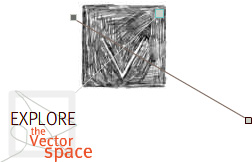The Agrippa Files
An Online Archive of Agrippa (a book of the dead)
Agrippa Files Editorial Team Statement
The Problem
How does one archive a memory book whose art and poetry was intended to disappear upon viewing, like memory before the invention of writing?
How does one share online a limited-edition art book that enjoyed the buzz it created on the early, "information wants to be free" net but also wanted to restrict access to the collector willing to pay $1,500 per copy?
What is the best way to digitize something that wanted to be both old and new media at the same time: a physical book with a diskette buried in its last pages?
In short, not just how do we work the mechanism of this paradoxical book? But, how can we keep it working (from William Gibson's included poem: "So that I remembered the mechanism")? How does one archive a book that is programmatically ephemeral?
Background
Agrippa (a book of the dead) appeared as a collaboration between artist Dennis Ashbaugh, author William Gibson, and publisher Kevin Begos, Jr. in 1992, just in time to catch the attention of both the mass media and the BBS's of the time as emblematic of the end of the book and the beginning of new media. Few copies of the physical book were actually ordered and produced, and only a handful of copies made it into publicly accessible collections. Instead, buoyed by the "cyperpunk" fame of Gibson, it was as if the book launched directly into cyberspace. Beginning with early rumors on the BBS's and the almost immediate online "hack" of Gibson's poem, it dissolved into an ephemera of memes and urban legends that overlaid the original work with what Gibson much later might have called a mystique of "pattern recognition." On his own web site, Gibson writes about Agrippa: "Today, there seems to be some doubt as to whether any of these curious objects were ever actually constructed. I certainly don't have one myself. Meanwhile, though, the text escaped to cyberspace and a life of its own, which I found a pleasant enough outcome."
Granted access to the documentary archives of Kevin Begos and permission to reproduce selected pages from the book, the editorial team behind The Agrippa Files set out to present the original Agrippa as the archive of its own coming-into-being and also of its transmission into publicity, myth, and scholarship. Launched on December 9, 2005, to coincide with the thirteenth anniversary of the "Transmission" (when live readings and images of the scrolling text of Gibson's self-encrypting poem were simulcast), The Agrippa Files is a scholarly site that features selected pages from the art book; a unique archive of materials dating from the book's creation and early reception; a simulation of what the book's intended "fading images" might have looked like; a video of the 1992 "transmission"; a "virtual lightbox" for comparing and studying pages; full-text scholarly essays and interviews; an annotated bibliography of scholarship, press coverage, interviews, and other material; a detailed bibliographic description of the book; and a discussion forum.
The Solution
How, then, to archive a work that so programmatically performs ephemerality?
Imagine being the archivist, curator, or editor of a nuclear warhead. Publish the thing (fire the missile), and it disappears. Open it (trigger the implosion of enriched heavy elements), and it disappears. Read it (gamma, alpha, and photon particles searing right through the retina directly into the brain), and you disappear. How to preserve that?
The solution attempted by The Agrippa Files is to archive the fallout pattern. (Not only have the distressed outer casing and singed pages of Agrippa been compared to relics from a future apocalypse, but critic Peter Schwenger notes that Gibson's father worked on the Manhattan Project.) More fully, the solution is to archive both the original production environment and the downwind radiation of the work into media streams both old and new.



